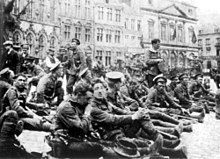Battle of Mons
| Battle of Mons | |||||||
|---|---|---|---|---|---|---|---|
| Part of the Battle of the Frontiers of World War I | |||||||
 "A" Company of the 4th Battalion, Royal Fusiliers (City of London Regiment), part of 9th Brigade of 3rd Division, resting in the town square at Mons before entering the line prior to the Battle of Mons. The Royal Fusiliers faced some of the heaviest fighting in the battle and earned the first Victoria Cross of the war. |
|||||||
|
|||||||
| Belligerents | |||||||
|
|
|
||||||
| Commanders and leaders | |||||||
|
|
|
||||||
| Strength | |||||||
| 2 corps 1 cavalry division 1 cavalry brigade total: 80,000 men and 300 guns |
4 corps 3 cavalry divisions total: 160,000 men and 600 guns |
||||||
| Casualties and losses | |||||||
| 1,638 | 2,000 | ||||||
The Battle of Mons was the first major action of the British Expeditionary Force (BEF) in the First World War. It was a subsidiary action of the Battle of the Frontiers, in which the Allies clashed with Germany on the French borders. At Mons, the British Army attempted to hold the line of the Mons–Condé Canal against the advancing German 1st Army. Although the British fought well and inflicted disproportionate casualties on the numerically superior Germans, they were eventually forced to retreat due both to the greater strength of the Germans and the sudden retreat of the French Fifth Army, which exposed the British right flank. Though initially planned as a simple tactical withdrawal and executed in good order, the British retreat from Mons lasted for two weeks and took the BEF to the outskirts of Paris before it counter-attacked in concert with the French, at the Battle of the Marne.
Britain declared war on Germany on 4 August 1914 and on 9 August the BEF began embarking for France. Unlike Continental European armies, the BEF in 1914 was exceedingly small. At the beginning of the war the German and French armies numbered well over a million men each, divided into eight and five field armies respectively; the BEF had c. 80,000 soldiers in two corps of entirely professional soldiers made up of long-service volunteer soldiers and reservists. The BEF was probably the best trained and most experienced of the European armies of 1914. British training emphasised rapid-fire marksmanship and the average British soldier was able to hit a man-sized target fifteen times a minute, at a range of 300 yards (270 m) with his Lee–Enfield rifle. This ability to generate a high volume of accurate rifle-fire played an important role in the BEF's battles of 1914.
...
Wikipedia
